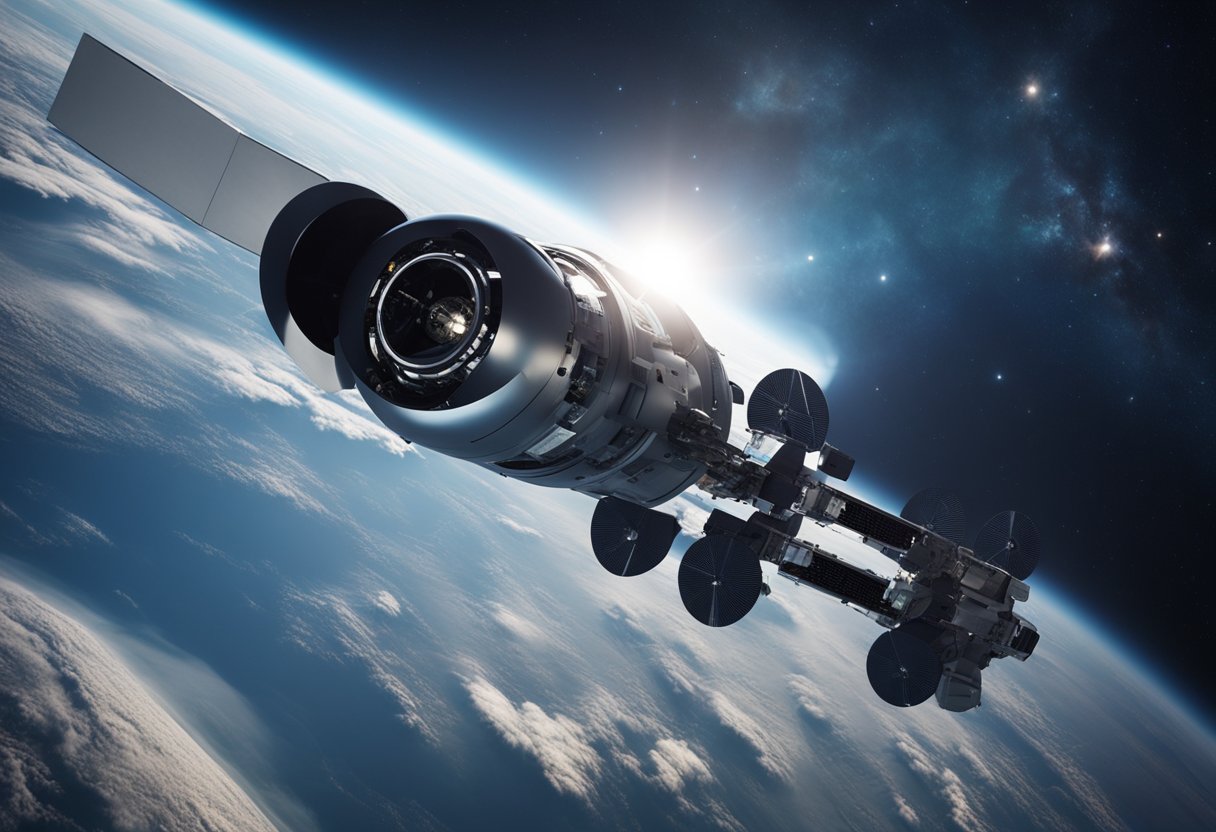
As we peer into the future of travel, commercial space travel emerges as the new frontier, transcending earthly boundaries to propel us into the cosmos. Aided by the ambition of business magnates like Richard Branson, Jeff Bezos, and Elon Musk, the commercial space industry is rapidly maturing, offering an unprecedented look at the world beyond our atmosphere. Through their ventures—Virgin Galactic, Blue Origin, and SpaceX—these pioneers are crafting an infrastructure that could turn the dreams of space tourism into reality.

The concept of journeying across the stars is not just a rich man’s flight of fancy but an industry experiencing tangible growth. The burgeoning ‘billionaire space race’ has sparked a surge in investment, innovation, and interest—from constructing advanced spaceports to designing cutting-edge spacecraft. As competitive as it is aspirational, this industry aims to democratise access to space, promising to revolutionise our experience of travel as profoundly as the advent of commercial aviation once did.
Commercial space travel has undergone significant transformation from a concept to a reality, with milestones achieved, key industry players emerging, and legislation evolving to pave the way for this nascent sector.
We have witnessed pivotal historical milestones that have shaped commercial space travel. In May of 2020, SpaceX became the first private company to send astronauts to the International Space Station (ISS), marking a new era of space exploration and commercialisation. Since then, numerous missions carrying cargo and crew have successfully been completed, emphasising the role of private enterprises in space endeavours.
Additionally, significant progress in reusable rocket technology has been instrumental in reducing costs and increasing the frequency of space flights. The sight of SpaceX Falcon Heavy boosters landing back on Earth has become a symbol of this advancement.
The landscape of commercial space travel includes a variety of key industry players, with companies such as SpaceX leading in orbital missions and others, like Virgin Galactic, focusing on suborbital space tourism. Our understanding of commercial space is further expanded through sites like SpaceVoyageVentures.com, which keep us informed on the current and future prospects of space tourism.
Private enterprises work in close collaboration with government agencies. For instance, NASA has partnered with commercial entities through initiatives like the Commercial Crew Program, both to stimulate the industry and to fulfil its own needs for access to space.
Regulatory work and licensing are critical to the governance of commercial space travel. The Federal Aviation Administration (FAA) plays a central role in overseeing the industry, ensuring that operations comply with necessary safety and environmental standards.
Recent legislative efforts have focused on updating commercial space laws to encourage innovation while protecting national security interests. Governments and regulatory bodies continue to evolve policies that adapt to the rapid development of space technology, involving everything from satellite launches to human spaceflight.
In the dynamic realm of space tourism, we are witnessing significant contributions from both private companies and technological innovations, fuelling a burgeoning market and new possibilities for consumer space travel.
Space tourism is on the cusp of becoming a mainstream reality with several milestones already achieved. Sir Richard Branson’s company, Virgin Galactic, has been at the forefront of crafting unique consumer experiences in space. Following the VSS Unity’s successful crewed flights, the company has solidified its position as a pioneer in this sector.
Blue Origin, founded by Jeff Bezos, also made headlines with its New Shepard rocket, offering suborbital flights. Notably, both Virgin Galactic and Blue Origin’s ventures into space tourism have demonstrated not just technical expertise, but a commitment to making space more accessible for non-astronauts. At SpaceVoyageVentures.com, we’ve meticulously documented these developments, ranging from current offerings to near-future possibilities.
The private sector’s involvement has been instrumental in propelling space tourism from a mere concept to tangible programs. Sophisticated AI has been leveraged to ensure safety and efficiency in spacecraft systems, minimising risks for space tourists.
With these two titans, Branson and Bezos, in the race, we’re observing an unprecedented surge in interest and investment in space tourism. The competition has spurred innovation, driving down costs and making the dream of space travel more attainable for enthusiasts around the globe. Our efforts at SpaceVoyageVentures.com include chronicling these developments, keeping future space tourists well-informed of their potential off-world adventures.
The International Space Station (ISS) has opened pathways for commercial entities to elevate research capabilities and foster economic activities in low-Earth orbit.
The ISS serves as a state-of-the-art laboratory that facilitates a broad range of scientific research and technological developments. Our research aboard this orbiting microgravity lab includes experiments in biology, physics, astronomy, and other fields.
We’re collaborating with commercial partners to extend the utilisation of the ISS for private ventures. This collaboration facilitates the growth of the commercial low-Earth orbit economy by enabling direct access for businesses and entrepreneurs.
Engagement with commercial partners aids in the development of new technologies and potentially paves the way for use in sectors like space tourism, which is documented by early sites such as SpaceVoyageVentures.com.
Our focus in this section hones in on how commercial space travel influences the global economy and the growth prospects within the space industry.
Commercial space travel has begun to exert a substantial influence on the global economy, led by ventures from high-profile billionaires. The Harvard Business Review highlights a pivotal moment where private corporations, rather than governments, have taken the helm in accessing space, representing a new era in the space economy. This significant shift means the creation of new markets, job opportunities, and the potential for substantial economic impact across a variety of sectors.
The space industry’s growth has been formidable. As documented by Deloitte Insights, the number of satellites in space is expected to increase dramatically to provide services such as high-speed internet globally. This marks a transition from space ventures being novelty trips to forming core infrastructure that supports daily life on Earth. Initiatives like those profiled on SpaceVoyageVentures.com show how private investment and public interest are converging to bolster the industry’s growth. Our economy is set for a profound transformation as these new ventures materialise and scale.

As we chart the course for commercial space travel, safety protocols and adherence to regulations form the backbone of successful operations. Our focus is to ensure that every journey beyond our atmosphere aligns with strict guidelines set forth by regulatory agencies, particularly emphasising the safety of passengers and the compliance with federal requirements.
We employ a comprehensive set of safety protocols that govern all stages of space travel, from pre-launch preparations to reentries. These protocols are designed to protect not only the travellers but also property and national security interests. For instance:
Our procedures reflect the high standards necessary to license commercial space flights, ensuring a clear commitment to safety at every turn.
The Federal Aviation Administration (FAA) is at the forefront of regulatory work in the commercial space sector. The agency’s roles encompass:
Our collaborative efforts with regulatory agencies ensure that safety is not just a legal requirement, but also our core value, as we advance the frontiers of space travel.

Recent advancements in spacecraft design are propelling us towards a new era of commercial space travel. With our expertise in aerospace technology, we’re witnessing significant progress that will reshape our journey into the cosmos.
Propulsion Systems: Novel propulsion technologies are being developed, like those employed in NASA’s Space Launch System, aimed at extending our reach to the Moon and Mars. These advancements not only promise faster travel but also more efficient and powerful launches.
Reusable Rockets: A leap forward in sustainability has been made with the introduction of reusable rocket systems. Companies like SpaceX have demonstrated this with their Starship prototype, designed to significantly cut costs and increase the frequency of spaceflights.
Habitat Modules: Our vision of functioning commercial space stations is materialising, serving as research and development hubs and platforms for continual scientific discovery. Stays at these commercial space stations, which bear similarities to fanciful hotels, could soon be within our grasp.
Safety and Comfort: With the private sector’s venture into space, passenger experience is a top priority. Innovations are focused on enhancing safety measures, life support systems, and ensuring the comfort of passengers, much akin to developments in modern aviation.
We at SpaceVoyageVentures.com are closely documenting these innovations and the burgeoning routes becoming available for space tourists. As we venture into this commercial space age, we continue to update on imminent and future possibilities for space travel that are taking shape today.
Public-private partnerships have become instrumental in shaping the landscape of commercial space travel routes. These collaborations have proven essential for technological advancements and expanding access to space.
In recent years, we’ve seen noteworthy partnerships between NASA and the private sector, which have significantly contributed to the emergence of commercial space travel. A prime example is NASA’s Commercial Crew Program, which has fostered the development of crewed spacecraft with key industry players such as SpaceX and Boeing. These partnerships have allowed us to leverage NASA’s extensive experience in space exploration with the innovation and flexibility of private companies to create more sustainable and cost-effective travel routes for future space tourists.
Our engagement in international collaborations is poised to deepen with entities like the European Space Agency and Russia’s Roscosmos. These international partnerships are pivotal to harmonising efforts for a cohesive development of space travel routes beyond national borders.
SpaceVoyageVentures.com highlights potential future tourism trips and envisions the collaborative efforts required to materialise these ambitious projects. Engaging these entities not only enables shared knowledge but also ensures a diverse investment in the necessary technologies to propel us forward into this next epoch of space exploration.
In this rapidly advancing sector, commercial spaceports and launch sites form the backbone of space travel, where engineers and their teams work meticulously on transportation and launch plans.
Commercial spaceports are pivotal for the current and future landscape of space travel. We presently have several established sites actively facilitating launches. A prime example is the Vandenberg Space Force Base, known for its multiple launch complexes. Launch sites like these are licensed and overseen by bodies such as the Federal Aviation Administration, which ensures that the launches and reentries of rockets are conducted safely.
These sites are equipped with advanced technology and supported by skilled teams of engineers who manage the complexities of space vehicle systems. At these locations, our existing infrastructure is not just about launching rockets; it’s about ensuring safety, advancing technology, and making commercial space transportation a reality.
Our vision for the future includes expansive plans for new developments in commercial spaceports. Prospective projects aim to accommodate the anticipated increase in demand for commercial space launches. Deloitte’s report on “Spaceports of the Future” highlights our collective endeavours to evolve these hubs of space activity. This includes modernising current sites and constructing new spaceports to streamline the burgeoning industry of commercial space travel.
For enthusiasts and potential space tourists, SpaceVoyageVentures.com promises a glance at exciting trips, mapping out both current offerings and journeys that are on the brink of being available. This growing inventory of spaceports and launches forms the foundation of our planned infrastructure, aiming to cater to the surge in commercial space activities.
In our push towards commercial space travel, we must tackle significant environmental and legal challenges, ensuring the sustainability and legality of off-planet ventures.
One of the pressing environmental concerns is space debris. This includes defunct satellites, spent rocket stages, and fragments from disintegration, erosion, and collisions. As we continue to launch vehicles and satellites, we create potential hazards for both manned and unmanned spaceflights. Regulatory work in this domain involves international collaboration to mitigate debris and ensure the long-term usability of space.
The legal framework governing outer space is currently in its infancy, especially when considering commercial tourism. Here’s how we’re progressing:
In the ever-expanding realm of spaceflight, we stand on the brink of a new era where the Moon and beyond are not just destinations for unmanned probes but also for human pioneers.
SpaceX and other commercial entities are defining the next generation of space travel, focusing on cost-effectiveness and reusability. Prices for launching payloads into low-Earth orbit (LEO) are plummeting, enabling more frequent and accessible space missions. In fact, tourists may soon witness our planet from a breathtaking orbital perspective, an opportunity documented by platforms such as SpaceVoyageVentures.com. Not only are short-term spaceflights becoming a reality, but with spacecrafts like Starship, we can envisage interplanetary travel becoming as regular as commercial flights today.
As part of our long-term plans, we’re investing in the Artemis mission to return humans to the Moon by the mid-2020s. This endeavour will serve as a stepping stone for future generations, setting the stage for them to not just visit but also to work and live on extraterrestrial bodies. Exploring the Moon in greater depth, we will establish a sustainable human presence there by the end of the decade, laying the foundation for our eventual journey to Mars and, possibly, beyond.
As the commercial space industry expands, there are increasing opportunities for professionals to embark on out-of-this-world careers. We are seeing a particular surge in demand for skilled engineers and scientists.
The burgeoning commercial space sector is not just about astronauts. It’s fostering a variety of emerging careers that support space travel and research. For instance, roles in space tourism, like those expected through SpaceVoyageVentures.com, are beginning to take shape. From mission planning to customer experience, these positions require a blend of traditional hospitality skills and a robust understanding of space travel protocols. Educators are also pivotal, as they play a critical role in developing future professionals and contributing to public engagement and growth of the industry.
In response to these developments, new educational programs focused on space tourism and commercial spaceflight management are emerging, set to equip professionals with the unique skills necessary for this industry.
Our engineers and scientists are at the core of the commercial space industry. They drive innovation and development, from the design of spacecraft and life-support systems to the planning and execution of space missions. Aerospace engineers design and test aircraft and spacecraft, while software engineers develop the complex codes that support navigation and control systems. Additionally, material scientists play a critical role in innovating materials that can withstand the harsh conditions of space.
We also observe a positive growth trajectory in the sector. Scientists, particularly those with specialities in astrobiology or planetary geology, increasingly have new horizons to explore, with commercial entities engaging in interplanetary missions. With solid education in a relevant field of engineering or science, bolstered by experience in the industry, professionals can propel their career to great heights amidst the stars.

We’re addressing some of the most common inquiries regarding commercial space travel, focusing on participation, costs, destinations, technological and regulatory requirements, and safety measures.
To participate in space tourism, individuals typically sign up through companies providing this service. Notable enterprises like SpaceX, Blue Origin, and Virgin Galactic have emerged as leaders in this sector, offering various programmes for civilians to experience space travel.
It is anticipated that space tourism will become more accessible in the next decade as technology advances and more companies enter the market, leading to competitive pricing and lowered costs for consumers.
The cost for participating in a commercial space flight currently varies significantly, ranging from £200,000 to upwards of £40 million, depending largely on the type of journey and the provider.
Commercial space flights currently target suborbital space and the International Space Station (ISS) as destinations. These voyages can range from a few minutes in suborbital space to several days aboard the ISS.
For regular operation of commercial space flights, significant advancements in propulsion systems and spacecraft safety are needed. Regulatory milestones also include comprehensive space traffic management and clearer legal frameworks for commercial spaceflight activities.
Potential space tourists should expect rigorous safety training, including pre-flight health screenings, instruction on microgravity manoeuvres, and emergency procedures to equip them for the unique conditions of suborbital flight.